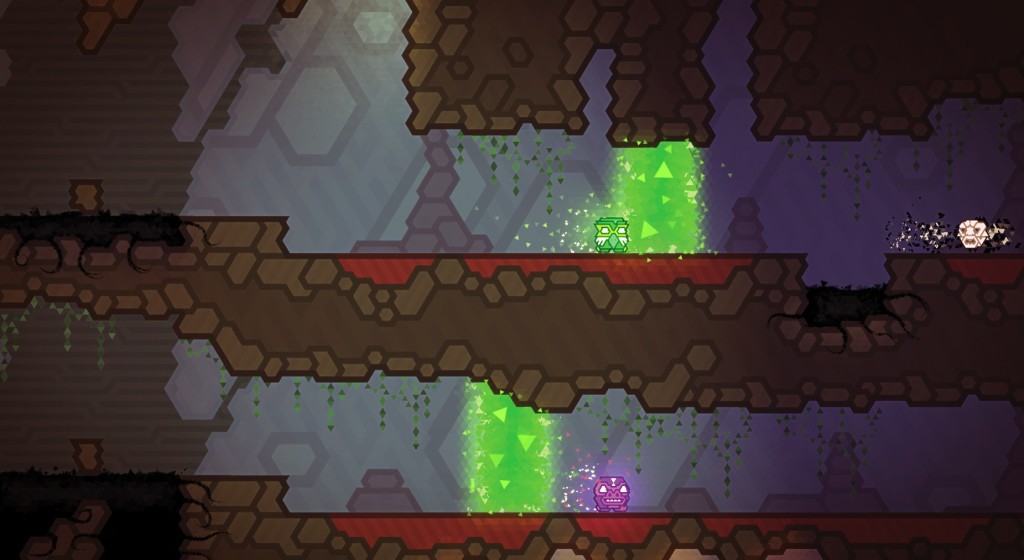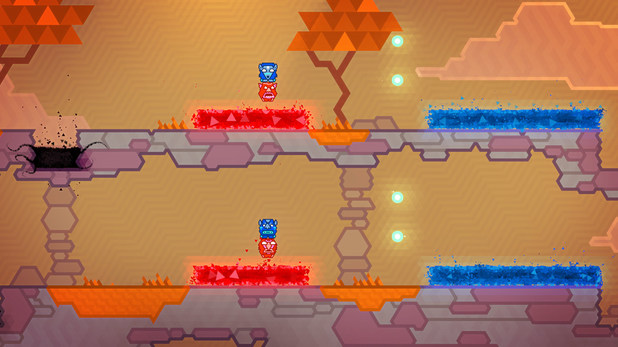Last updated on April 19, 2014
Project Totem turns platforming on its head by making you control two to four characters at once. That isn’t incredibly innovative, of course; other games have done this exact same concept at one point or another. I happen to like its implementation here for a variety of reasons.
First, Press Play employs a minimalist paedegogical methodology. For those of us who do not know super smart word in the previous sentence, it teaches you without teaching you. And, to dumb it down a little further, it doesn’t have a tutorial. Simply by playing the game, rather than observing a tutorial or seeing the AI play out something for you, Project Totem forces learning via active participation.
Obviously, this does not succeed for every genre, but it’s very easy to get the basics. You, in single player, control two different characters. One exists in the top side of the screen, and one in the bottom side of the screen. Each piece of the totem (hence the game name) represents a different color, and most every puzzle revolves around that central concept. See, totems can only enter into areas that retain the same color as themselves; enter one of the opposite color, and the game sets you back a few feet. You could instantly recognize and learn this, even if you’ve never played a video game before: failure means loss of progress.
I am merely conveying this with words, but the effect is much more striking when actually playing it. No incessant tutorializing, no plot exposition, and no context-setting overtake the proceedings in any way, shape, or form. If you want to call any game a “pure” game, then Project Totem certainly fits that bill.
You’ll find out naturally that, for example, totem parts stack on top of each other, and that you will need this skill in a variety of situations. Your totem pieces can jump, as you’d suspect, but the stacking actually creates a double jump as one totem part pops off the other. Sometimes you’ll need to land them on different areas, and that requires some practice! I’d call the control precise and intuitive, all said.
All of these elements allow Press Play to really push a model of increasing and novel difficulty. Per its obvious genre inspirations, it slowly increases the challenge, complexity, and dexterity for each obstacle. Monitoring two objects on a screen at the same time requires some concentration, especially when Project Totem starts implementing its “switch” mechanic. You can switch the place of your totems from one part of the screen to the other, and you’ll need to do this in many long sequences. I especially liked the one in the demo where you fall down a giant color-coded chasm, switching repeatedly. I knew I switched too much towards the end, and needed to adjust slightly to nail the timing, but that process was fun. How often do you see that in video games these days? An actual learning curve that goes up over time? Gasp!
Interestingly, and probably naturally, the whole concept lends itself to a co-operative mode. However, rather than merely letting each player controlling one totem, each player controls two. Think quadruple jump! You can imagine many strange variations of totems jumping, falling, and landing in precise spots or you fail. If this turns into a couch co-op game, than I am completely up for that in every way. Even at PAX, i played with someone else and had a fantastic time trying to coordinate our movements successfully. Any good co-op game requires some modicum of teamwork, and Project Totem’s pick-up-and-play nature turns co-op into an easy sell.
Of course, I think the big question on my mind is: should I be praising developers for doing exactly what they should be doing? I think so. It appears, from my reckoning, that a lot of indie developers are starting to really understand and employ what made their favorite games so enjoyable. A few years ago, I would have said “indie games are dumb”, precisely because they were trying WAY TOO HARD to be “important”. Now, that seems like a tiny subset of a tiny audience of all video gaming peoples. Indie video games are made by video gamers who want to recapture that magic of the past.
And what is that magic, you ask? To put words on the ineffable: transportation to other worlds through the means of rules and systems affixed onto an interesting world. Video games give us something to participate, wonder, observe, and marvel. Creativity abounds in tight structures, and video games provide a perfect contrast of rules and aesthetics both via systemtic implementation. For a brief shining moment, every game transports you beyond just being a video game, and being something rather awesome. It’s the same sort of wonder you get when Jesus does a miracle in Luke 5:
He said to the paralytic—“I say to you, get up, and pick up your stretcher and go home.” 25 Immediately he got up before them, and picked up what he had been lying on, and went home glorifying God. 26 They were all struck with astonishment and began glorifying God; and they were filled with fear, saying, “We have seen remarkable things today.”
It is something wonderful, out of the ordinary, and striking. We are removed from things as they were for a second, and see reality in a different light. Synapses light up in your brain as the entire structure magically comes together, and you can’t quite identify the why. But does it work? That answers seems pretty clear at this point:yes.
Project Totem does that for me, albeit in a way more mortal (har). By knowing what it is, and what it isn’t, PressPlay succeeds in a way I can thoroughly recommend even in its very early development state.


